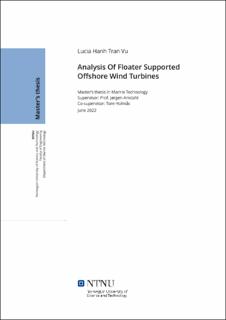| dc.contributor.advisor | Amdahl, Jørgen | |
| dc.contributor.advisor | Holmås, Tore | |
| dc.contributor.author | Vu, Lucia Hanh Tran | |
| dc.date.accessioned | 2022-09-20T17:19:29Z | |
| dc.date.available | 2022-09-20T17:19:29Z | |
| dc.date.issued | 2022 | |
| dc.identifier | no.ntnu:inspera:106583545:34557688 | |
| dc.identifier.uri | https://hdl.handle.net/11250/3019853 | |
| dc.description.abstract | Forbedrede fornybare løsninger blir kontinuerlig studert og evaluert med fokus om å redusere det menneskeskapte CO2-fotavtrykket. En av de mest lovende fornybare energiressursene de kommende tiårene er flytende vindkraft. Designutvikling av en vindturbin er en iterativ prosess som involverer tidkrevende teknisk analyser som betinger mye datalagring. Formålet med denne oppgaven er å designe en forenklet vindturbinmodell som tilsvarer og opererer som en ordinær fullmontert vindturbin. Oppgaven har en ambisjon om en betydelig reduksjon av beregningstid og behandlingsdata, og likevel oppnå pålitelige og presise resultater.
Etablering av simplifisert og modifisert struktur i USFOS baserer seg på en matematisk forenkling. Denne forenklingen implementerer en ekvivalent demper og konsentrert nodelast som erstatter og representerer rotoren og bladene på den ordinære fullmonterte vindturbinen. Responsene og kreftene for den forenklede og den sammensatte turbinen analyseres og sammenliknes for å kalkulere utmattelseslevetiden. Diskusjonen av utmattingssensitiviteten kartlegger kvalitetsnivået og nøyaktigheten til vindturbin-modifikasjonen.
Beregningstiden og kostnadene for utmattingsanalysene er omfattende. Å oppnå tidsreduksjon ved simulering og samtidig opprettholde høy nøyaktighet er utfordrende arbeid. Evaluering viser ar den forenklede modellen likevel oppnår lignende utmattingsresultater som den komplette vindturbinen ved å bruke en dempning som tilsvarer omtrent 8 % av konstruksjonens kritiske demping. Mengden demping er noe sensitiv og blir påvirket av de ulike omgivelsene. | |
| dc.description.abstract | Improved renewable solutions are constantly investigated and evaluated to reduce the human-produced CO2 footprint. One of the most promising renewable energy resources in the coming decades is floating wind energy. Design development of a wind turbine is an iterative process that employs time-consuming technical analysis, which requires great data storage. This thesis aims to design a simplified wind turbine model that corresponds to and operates as an ordinary full assembled wind turbine. It also includes an ambition of significantly reducing computational time and processing data yet obtaining reliable and precise results.
Establishing the modified structure in USFOS applies a mathematical simplification. This simplification implements an equivalent damper and a concentrated node mass that replaces and represents the rotor and blades of the full assembled wind turbine. The responses and forces for the simplified and assembled turbine are analyzed to calculate the fatigue life. The discussion of fatigue sensitivity identifies the quality level and accuracy of the wind turbine modification.
Computational time and cost of fatigue assessments are massive, and achieving a simulation time reduction while maintaining high accuracy is challenging. Although, the simplified model obtains similar fatigue results as the complete wind turbine by applying a damper equal to approximately 8 % of the critical damping of the structure. The damping magnitude appears somewhat sensitive and dependent on specific environmental conditions. | |
| dc.language | eng | |
| dc.publisher | NTNU | |
| dc.title | Analysis Of Floater Supported Offshore Wind Turbines | |
| dc.type | Master thesis | |
